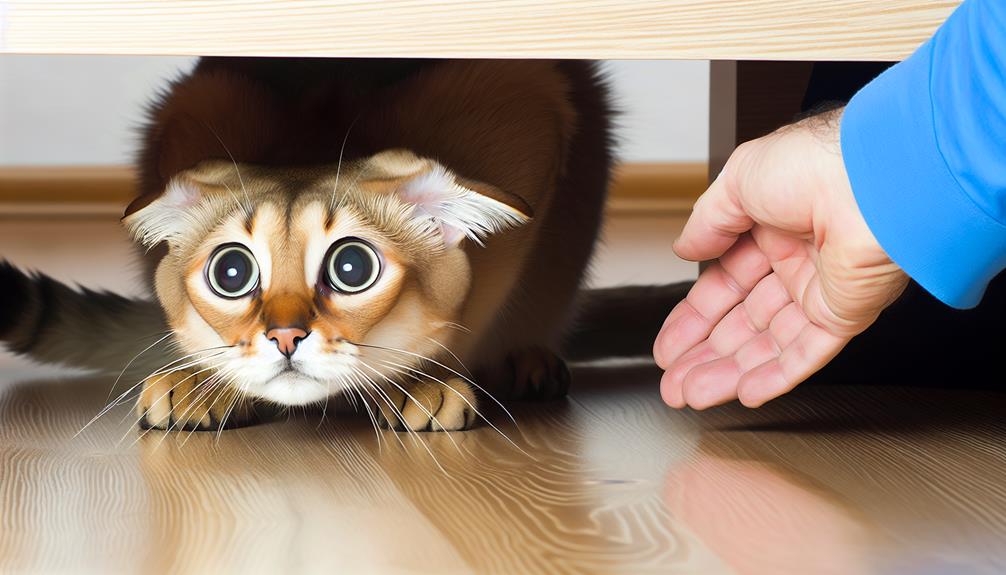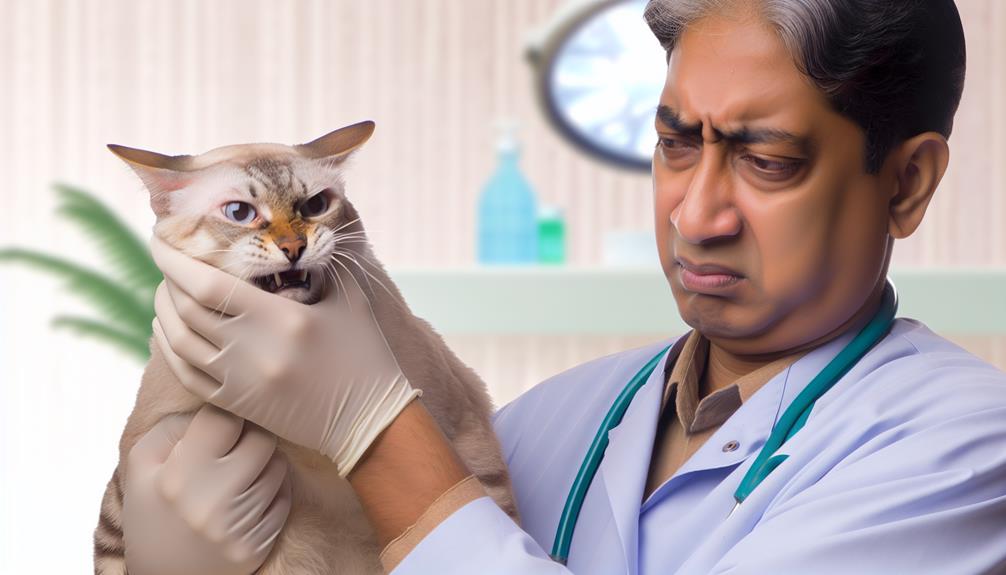Ever wondered why your cat suddenly bites you, seemingly out of nowhere? It's a common issue many cat owners face, and the reasons can vary widely. Sometimes, it's just playful behavior linked to their hunting instincts. Other times, it might be a sign of overstimulation, fear, anxiety, or even a territorial response. And then, there are medical issues that could be the hidden culprit. Understanding these underlying causes is key to addressing and preventing those unexpected nips. Curious about what might be triggering your cat's biting behavior? Let's explore further.
Playfulness and Hunting Instincts
When it comes to understanding why your cat bites you, it's vital to take into account their playfulness and innate hunting instincts. Cats exhibit play behavior that can sometimes be misinterpreted as aggression. This play behavior is an instinctual response derived from their predatory drive. Young kittens, in particular, engage in mock hunting activities which include pouncing, chasing, and yes, biting. These actions are important for developing their hunting skills and are ingrained in their DNA.
Your cat's biting during play is often a manifestation of their social interaction with you. In the wild, cats engage in social play with their littermates and mothers to learn the boundaries of acceptable behavior. When domesticated cats play with humans, they often use their mouths as a primary tool for interaction, mimicking the behaviors they would exhibit with other cats. Consequently, a bite might not be intended to harm but rather to simulate a natural hunting experience.
Scientific evidence suggests that a cat's predatory drive is a fundamental aspect of their behavior. Even though domesticated, they retain the instinct to stalk, pounce, and capture prey. This drive can be triggered during play sessions, particularly if the play mimics the movements of prey animals. Toys that resemble mice or birds can stimulate this predatory behavior, leading to increased biting.
Understanding that your cat's biting is a complex interplay of play behavior, instinctual response, and social interaction can help you manage and redirect this activity. By providing appropriate outlets for their predatory drive, such as interactive toys, you can mitigate the biting and enhance your bond with your feline companion.
Overstimulation
While playfulness and hunting instincts are significant factors, another common reason your cat might bite is overstimulation. Overstimulation occurs when a cat's sensory receptors become overwhelmed, often during petting or play. This can lead to a sudden change in behavior, such as biting, as a way for the cat to communicate discomfort. Understanding feline communication and cat body language is vital in identifying and preventing overstimulation.
Cats have several subtle cues to indicate they're reaching their threshold of tolerance. Signs of overstimulation include a twitching tail, flattened ears, wide eyes with dilated pupils, and skin rippling along the back. Ignoring these signals may result in a bite as the cat's way of saying, "I've had enough."
Scientific evidence supports that cats have varying thresholds for tactile stimulation. A study published in the journal "Applied Animal Behaviour Science" found that individual cats exhibit different tolerance levels for petting. Some cats may enjoy prolonged affection, while others can only tolerate brief interactions. As a result, it is important to observe your cat's body language closely to recognize when they're nearing overstimulation.
To mitigate the risk of a bite, practice mindful petting sessions. Start with short interactions and pay close attention to your cat's feline communication signals. If you notice signs of overstimulation, stop petting immediately to prevent a negative response. Gradually, you can learn your cat's preferences and limits, fostering a more harmonious relationship.
Fear and Anxiety

Fear and anxiety are significant contributors to why your cat might bite. When a cat experiences fear, it often perceives a threat, leading to defensive behaviors such as biting. Fear signals in cats can include dilated pupils, flattened ears, and a puffed-up tail. These physiological responses are part of the cat's fight-or-flight mechanism, a survival instinct deeply ingrained through evolution.
Understanding anxiety triggers is vital in preventing fear-induced biting. Common anxiety triggers for cats include sudden loud noises, unfamiliar environments, or the presence of other animals. A study published in the Journal of Veterinary Behavior highlighted that exposure to such stressors can lead to heightened aggression and biting in cats. Identifying these triggers allows you to create a more stable and secure environment, minimizing your cat's stress levels.
Cats often bite as a way to communicate their discomfort or fear. For instance, if your cat is cornered or feels that it has no escape route, biting becomes a last-resort defense mechanism. It's important to recognize these fear signals early to intervene before your cat resorts to biting. Behavioral modification techniques and environmental enrichment can be effective strategies to reduce anxiety in cats.
Moreover, consulting a veterinarian or a feline behavior specialist can provide additional insights and tailored interventions. They may recommend pheromone diffusers, anti-anxiety medications, or specific behavioral therapies. Scientific evidence supports these methods as effective means to alleviate anxiety-related behaviors, including biting. By addressing your cat's fear and anxiety, you can cultivate a more harmonious relationship and reduce the likelihood of biting incidents.
Territorial Behavior
Territoriality is a fundamental behavioral trait in cats, deeply rooted in their instinctual drive to establish and defend their domain. Cats are naturally territorial animals, and this behavior manifests in various forms, including territorial marking and resource guarding. When your cat bites you, it might be a sign that it feels its territory is threatened.
Territorial marking typically involves behaviors like urine spraying, cheek rubbing, and scratching. These actions deposit scent markers that delineate the cat's territory, providing a sense of security. Resource guarding, on the other hand, is when a cat aggressively defends food, toys, or even favorite resting spots from perceived intruders, including humans.
| Behavior | Description |
|---|---|
| Urine Spraying | Marking territory with urine to warn other cats |
| Cheek Rubbing | Depositing pheromones from facial glands on objects |
| Scratching | Leaving visual and scent marks on surfaces |
| Aggressive Guarding | Defending resources like food, toys, or sleeping areas |
In a multi-cat household, territorial disputes can escalate to biting. Scientifically, this behavior is driven by the cat's need to control its environment and resources. When you approach a spot your cat considers its own, or try to take away a cherished toy, the cat may react with a bite as a form of resource guarding.
It's essential to observe and understand the specific triggers leading to these territorial behaviors. Avoiding actions that provoke territorial aggression and providing ample resources and spaces can alleviate tension. Recognizing these patterns empowers you to create a harmonious environment, reducing the likelihood of being bitten due to territorial issues.
Medical Issues

Medical issues can be a significant underlying cause of biting behavior in cats. When your feline companion suddenly starts to bite more frequently, it's vital to reflect on potential health-related factors. Dental problems and skin conditions are two primary medical issues that can trigger this behavior.
Cats experiencing dental problems may exhibit biting as a reaction to the pain and discomfort in their mouths. Conditions such as gingivitis, periodontal disease, or tooth abscesses can cause severe oral pain, leading your cat to bite in an attempt to communicate distress or protect the affected area. An expert evaluation by a veterinarian, including a thorough dental examination, is important to identify and address these issues. Studies have shown that dental diseases are prevalent in up to 85% of cats over the age of three, making it a common but often overlooked cause of behavioral changes.
Skin conditions, such as flea infestations, allergic dermatitis, or fungal infections, may also contribute to biting behavior. These conditions can cause significant irritation and itchiness, resulting in your cat biting at their skin or even lashing out when touched. A detailed dermatological examination can help pinpoint the specific skin condition affecting your cat. Treatments may include topical medications, dietary changes, or environmental adjustments, depending on the diagnosis.
Ignoring these medical issues can exacerbate your cat's discomfort and lead to more severe behavioral problems. Consequently, it's imperative to consult your veterinarian if you notice a sudden increase in biting behavior. Early diagnosis and treatment of dental problems and skin conditions can not only alleviate your cat's pain but also restore their usual, more affectionate demeanor.
Conclusion
In brief, your cat's biting behavior can stem from playfulness, overstimulation, fear, territorial behavior, or underlying medical issues. Recognizing these triggers is half the battle. By identifying the root cause, you can tailor your approach to mitigate this behavior. It's not a one-size-fits-all situation, and addressing each factor with appropriate strategies will help. Remember, an ounce of prevention is worth a pound of cure when it comes to managing your cat's biting tendencies.
